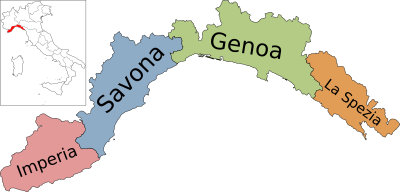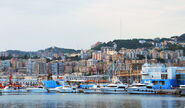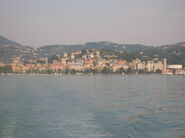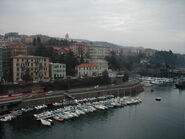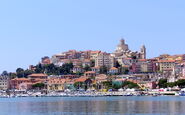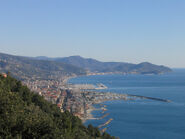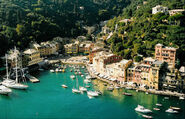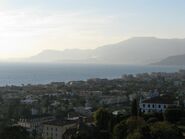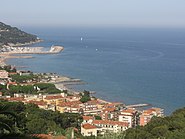| Liguria | |||
|---|---|---|---|
| — Region of Italy — | |||
|
|||
| Country | Italy | ||
| Capital | Genoa | ||
| Government | |||
| • President | Claudio Burlando (PD) | ||
| Area | |||
| • Total | 5,422 km2 (2,093 sq mi) | ||
| Population (1 January 2011) | |||
| • Total | 1,617,000 | ||
| • Density | 300/km2 (770/sq mi) | ||
| Time zone | CET (UTC+1) | ||
| • Summer (DST) | CEST (UTC+2) | ||
| GDP/ Nominal | € 44.1[1] billion (2008) | ||
| GDP per capita | € 27,100[2] (2008) | ||
| NUTS Region | ITC | ||
| Website | www.regione.liguria.it | ||
Liguria (Italian pronunciation: [liˈɡuːrja], Ligurian: Ligûria) is a coastal region of north-western Italy, where Genoa is the capital. The region is popular with tourists for its beautiful beaches, picturesque towns, and cuisine.
Geography[]
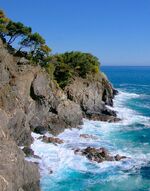
A view of Cinque Terre.
Liguria is bordered by France to the west, Piedmont to the north, and Emilia-Romagna and Tuscany to the east. It lies on the Ligurian Sea. The narrow strip of land is bordered by the sea, the Alps and the Apennines mountains. Some mountains rise above 2000 m; the watershed line runs at an average altitude of about 1000 m.
The winding arched extension goes from Ventimiglia to La Spezia Of this, 3524.08 kilometres are mountainous (65% of the total) and 891.95 square kilometres are hills (35% of the total). Liguria's Natural Reserves cover 12% of the entire region, or 60,000 hectares of land. They are made up of one National Reserve, six large parks, two smaller parks and three nature reserves.
The continental shelf is very narrow, and so steep it descends almost immediately to considerable marine depths along its 350-km coastline. Except for the Portovenere and Portofino promontories, it is generally not very jagged, and is often high. At the mouths of the biggest watercourses there are small beaches, but there are no deep bays and natural harbours except for those of Genoa and La Spezia.
The ring of hills lying immediately beyond the coast together with the sea account for a mild climate year-round. Average winter temperatures are 7 to 10 °C (45 to 50 °F) and summer temperatures of 23 to 24 °C (73 to 75 °F), which make for a pleasant stay even in the dead of winter. Rainfall can be abundant at times, as mountains very close to the coast create an orographic effect. Genoa and La Spezia can see up to 2,000 mm (79 in) of rain in a year; other areas instead show the normal Mediterranean rainfall of 500 to 800 mm (20 to 31 in) annually.
History[]
Prehistory and Roman times[]
Traces of Neanderthal Man were discovered in the region of Loano, whereas in Ventimiglia, in the grotto of "Balzi Rossi", numerous remains were found which recall those of Cro-Magnon Man. According to the written sources we have about the settlements of the Ligurians (Ligures), the presence of this people of Mediterranean origin dates back to the first millennium B.C. on a vast territory including most of north-western Italy. This people, divided into several tribes, numbered less than two hundred thousand.

The Roman amphiteatre of Luni (1st century AD).
During the first Punic War, the ancient Ligurians were divided, some of them siding with Carthage and a minority with Rome, whose allies included the future Genoese.[3] Eric Brousseau has argued in his recent award winning book on Liguria that Roman foreign policy towards Liguria was often determined by domestic politics and the personal ambition of individual Roman commanders, transforming Liguria into one of the most exciting regions in Roman Italy.[4] After the Roman conquest of the region, the so-called IX regio, named Liguria, was created in the reign of Princeps Augustus, when Liguria was expanded from the coast to the banks of Po River. The great Roman roads (Aurelia and Julia Augusta on the coast, Postumia and Aemilia Scauri towards the inland) helped strengthen the territorial unity and increase exchanges and trade. Important towns developed on the coast, of which evidences are left in the ruins of Albenga, Ventimiglia and Luni.
Middle ages[]

Simonetta Vespucci, a native Ligurian who was a famous beauty during the Renaissance, may have been the model for Botticelli's The Birth of Venus
Between the 4th and the 10th centuries Liguria was dominated by the Byzantines, the Lombards of King Rothari (about 641) and the Franks (about 774) and it was invaded by the Saracens (according to Arthur Hill Hassall, under Saracen occupation and rule from c. 876 – c. 972)[5] and the Normans. In the 10th century, once the danger of pirates decreased, the Ligurian territory was divided into three marches: Obertenga (east), Arduinica (west) and Aleramica (centre). In the 11th and 12th centuries the marches were split into fees, and then with the strengthening of the bishops’ power, the feudal structure began to partially weaken. The main Ligurian towns, especially on the coast, became city-states, over which Genoa soon extended its rule. Inland, however, fees belonging to noble families survived for a very long time.
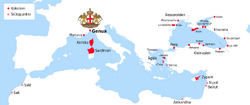
Territories of the Republic of Genoa (shown in red), 1400.
Between the 11th century (when the Genoese ships played a major role in the first crusade, carrying knights and troops to the Middle-East for a fee) and the 15th century, the Republic of Genoa experienced an extraordinary political and commercial success (mainly spice trades with the Orient). It was one of the most powerful maritime republic in the Mediterranean from the 12th to the 14th century: after the decisive victory in the battle of Meloria (1284), it acquired control over the Tyrrhenian Sea and was present in the nerve centres of power during the last phase of the Byzantine empire, having colonies up to Black Sea and Crimean.
After the introduction of the title of doge for life (1339) and the election of Simone Boccanegra, Genoa resumed its struggles against the Marquis of Finale and the Counts of Laigueglia and it conquered again the territories of Finale, Oneglia and Porto Maurizio. In spite of its military and commercial successes, Genoa fell prey to the internal factions which put pressure on its political structure. Due to the vulnerable situation, the rule of the republic went to the hands of the Visconti family of Milan. After their expulsion by the popular forces under Boccanegra’s lead, the republic remained in Genoese hands until 1396, when the internal instability led the doge Antoniotto Adorno to surrender the title of Seignior of Genoa to the king of France. The French were driven away in 1409 and Liguria went back under Milanese control in 1421, thus remaining until 1435.
Early modern[]

Posthumous portrait of Christopher Columbus by Sebastiano del Piombo.
The alternation of French and Milanese dominions over Liguria went on until the first half of the 16th century. The French influence ceased in 1528, when Andrea Doria became the prestigious ally of the powerful king of Spain and imposed an aristocratic government which gave the republic a relative stability for about 250 years.
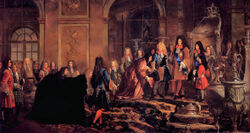
Reparation faite à Louis XIV par le Doge de Gênes.15 mai 1685 by Claude Guy Halle.
In the context of emerging western imperialism and economic competition between European kingdoms seeking wealth through the establishment of trade routes and colonies, Genoese explorer Cristopher Columbus's speculative proposal to reach the East Indies by sailing westward received the support of the Spanish crown, which saw in it a promise, however remote, of gaining the upper hand over rival powers in the contest for the lucrative spice trade with Asia. During his first voyage in 1492, instead of reaching Japan as he had intended, Columbus landed in the Bahamas archipelago, at a locale he named San Salvador. Over the course of three more voyages, Columbus visited the Greater and Lesser Antilles, as well as the Caribbean coast of Venezuela and Central America, claiming them for the Spanish Empire.
The impoverishment of the commercial routes with the Near East forced the Ligurian notables to engage, since then, in financial speculation. The international crises of the 17th century, which ended for Genoa with the 1684 bombardment by King Louis XIV’s fleet, restored the French influence over the republic. Right because of this influence, the Ligurian territory was traversed by the Piedmontese and Austrian armies when these two states came into conflict with Versailles. The limit was reached with the Austrian occupation of Genoa in 1746. The Habsburgic troops were driven away by a popular insurrection in the same year. Napoleon’s first Italy campaign marked the end of the secular republic which, by the Emperor's will, was transformed into Ligurian Republic, according to the model of the French Republic. After the union of Oneglia and Loano (1801), Liguria was annexed to the French Empire (1805) and divided by Napoleon into three departments: Montenotte, with capital Savona, Genoa and the department of the Apennines, with capital Chiavari.
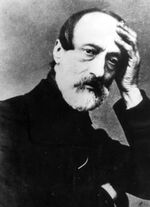
Giuseppe Mazzini was a patriot, philosopher and politician of the 19th century.
Late modern and contemporary[]
After a short period of independence in 1814, the Congress of Vienna (1815) decided that Liguria should be annexed to the Kingdom of Sardinia. The Genoese uprising against the House of Savoy in 1821, which was put down with great bloodshed, aroused the population’s national sentiments. Some of the most prestigious figures of Risorgimento were born in Liguria (Giuseppe Mazzini, Mameli, Nino Bixio). Italian patriot and general Giuseppe Garibaldi, who was born in the neighbouring Nice (then part of Sardinian state), started his Expedition of the Thousand on the evening of 5 May 1860 from a rock in Quarto, a quarter of Genoa.
In late 19th and early 20th century, the region’s economic growth was remarkable: steel mills and ship yards flourished along the coast from Imperia to La Spezia, while the port of Genoa became the main commercial hub of industrializing Northern Italy. During the tragic period of World War II Liguria experienced heavy bombings, hunger and two years of occupation by the German troops, against whom a liberation struggle was led among the most effective in Italy. When Allied troops eventually entered Genoa, they were welcomed by Italian partisans which, in a successful insurrection, had freed the city and accepted the surrender of the local German command. For this feat the city has been awarded the gold medal for military valour.
Demographics[]
| Historical population | ||
|---|---|---|
| Year | Pop. | ±% |
| 1861 | 829,000 | — |
| 1871 | 884,000 | +6.6% |
| 1881 | 936,000 | +5.9% |
| 1901 | 1,086,000 | +16.0% |
| 1911 | 1,207,000 | +11.1% |
| 1921 | 1,338,000 | +10.9% |
| 1931 | 1,423,000 | +6.4% |
| 1936 | 1,467,000 | +3.1% |
| 1951 | 1,567,000 | +6.8% |
| 1961 | 1,735,000 | +10.7% |
| 1971 | 1,854,000 | +6.9% |
| 1981 | 1,808,000 | −2.5% |
| 1991 | 1,676,000 | −7.3% |
| 2001 | 1,572,000 | −6.2% |
| 2011 | 1,617,000 | +2.9% |
| Source: ISTAT 2001 | ||
The population density of Liguria is much higher than the national average (300 inhabitants per km2, or 770 per sq mi), being inferior only to Campania's, Lombardy's and Latium's. In the province of Genoa, it reaches almost 500 inhabitants per km2, whereas in the provinces of Imperia and Savona it is less than 200 inhabitants per km2. The Spanish traveller Pedro Tafur, noting it from sea in 1436, remarked "To one who does not know it, the whole coast from Savona to Genoa looks like one continuous city, so well inhabited is it, and so thickly studded with houses,"[6] and today over 80% of the regional population still lives permanently near to the coast, where all the four major cities above 50,000 are located: Genoa (pop. 610,000), La Spezia (pop. 95,000), Savona (pop. 62,000) and Sanremo (pop. 56,000).
The population of Liguria has been declining from 1971 to 2001, most markedly in the cities of Genoa, Savona and La Spezia. The age pyramid now looks more like a 'mushroom' resting on a fragile base.[7] The negative trend has been partially interrupted only in the last decade when, after a successful economic recovery, the region has attracted consistent fluxes of immigrants. As of 2008, the Italian national institute of statistics, ISTAT, estimated that 90,881 foreign-born immigrants live in Liguria, equal to 5.8% of the total regional population.[8]
Economy[]
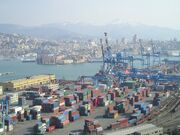
Genoa is the busiest seaport in Italy.
Ligurian agriculture has increased its specialisation pattern in high-quality products (flowers, wine, olive oil) and has thus managed to maintain the gross value-added per worker at a level much higher than the national average (the difference was about 42% in 1999).[9] The value of flower production represents over 75% of the agriculture sector turnover, followed by animal farming (11.2%) and vegetable growing (6.4%).
Steel, once a major industry during the booming 1950s and 1960s, phased out after the late 1980s crisis, as Italy moved away from the heavy industry to pursue more technologically advanced and less polluting productions. So the Ligurian industry has turned towards a widely diversified range of high-quality and high-tech products (food, shipbuilding, electrical engineering and electronics, petrochemicals, aerospace etc.). Nonetheless, the regions still maintains a flourishing shipbuilding sector (yacht construction and maintenance, cruise liner building, military shipyards).[9] In the services sector, the gross value-added per worker in Liguria is 4% above the national average. This is due to the increasing diffusion of modern technologies, particularly in commerce and tourism. A good motorways network (376 km in 2000) makes communications with the border regions relatively easy. The main motorway is located along the coastline, connecting the main ports of Nice (in France), Savona, Genoa and La Spezia. The number of passenger cars per 1000 inhabitants (524 in 2001) is below the national average (584). In average, about 17 million tones of cargo are shipped from the main ports of the region and about 57 million tonnes enter the region.[9] The Port of Genoa, with a trade volume of 58.6 million tonnes [10] it is the first port of Italy,[11] the second in terms of twenty-foot equivalent units after the port of transshipment of Gioia Tauro, with a trade volume of 1.86 million TEUs.[10] The main destinations for the cargo-passenger traffic are Sicily, Sardinia, Corsica, Barcelona and Canary Islands.
Government and politics[]

View of Portovenere
The politics of Liguria takes place in a framework of a presidential representative democracy, whereby the President of Regional Government is the head of government, and of a pluriform multi-party system. Executive power is exercised by the Regional Government. Legislative power is vested in both the government and the Regional Council. The Regional Government is presided by the Governor, who is elected for a five-year term, and is composed by the President and the Ministers, who are currently 11, including a Vice President.[12] The Regional Council of is composed of 40 members and it's elected for a five-year term, but, if the President suffers a vote of no confidence, resigns or dies, under the simul stabunt vel simul cadent prevision (introduced in 1999), also the Council will be dissolved and there will be a fresh election. In the last regional election, which took place on 28–29 March 2010, incumbent Claudio Burlando (Democratic Party) defeated Sandro Biasotti (an independent close to The People of Freedom). At both national and local level Liguria is considered a swing region, where no one of the two coalition is dominant.
Administrative divisions[]
Liguria is divided into four provinces:
| Province | Area (km²) | Population | Density (inh./km²) |
|---|---|---|---|
| Province of Genoa | 1,838 | 884,945 | 481.5 |
| Province of Imperia | 1,156 | 220,217 | 190.5 |
| Province of La Spezia | 881 | 222,602 | 252.7 |
| Province of Savona | 1,545 | 265,194 | 185.2 |
Culture[]
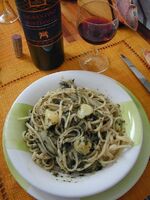
Pasta with pesto sauce, a traditional Ligurian recipe

Portofino bay
Mountains and steep cliffs that rise loftily out of the Ligurian Sea in the most northerly part of the Western Mediterranean. This is the fascinating landscape that will impress people on their journey through this historically rich and dynamic region. The capital Genoa, one of the most important ports in the Mediterranean and home to Christopher Columbus, was already a powerful maritime state in the Middle Ages. Today one can find impressive buildings, elegant mansions, and wonderful churches — all of which bear witness to Liguria's glorious past and which blend in perfectly with the modern city. In other parts of Liguria, there are also numerous historical treasures. An intact and luxuriant Mediterranean vegetation exists in the mountain regions of Portofino and Cinque Terre. On the other hand, Portovenere is a small jewel on the Mediterranean coast. Sanremo is one of Italy's most famous bathing resorts and the place where the annual Italian pop music festival takes place. The beautiful Benedict monastery S. Fruttuoso merits special attention. And needless to say there are many other important historical monuments to be explored.
Liguria is where pesto is originally from, one of the most popular sauces in Italian cuisine. Seafood is a major staple of Ligurian cuisine, as the sea has been part of the region's culture since its beginning. Another important aspect of the culture there is the beach. Tourists have been flocking to the Italian Riviera for decades to experience its calm, deep blue water.
Besides Italian, Ligurian, the native language, is widely spoken.
Gallery[]
References[]
- ^ "Eurostat – Tables, Graphs and Maps Interface (TGM) table". Epp.eurostat.ec.europa.eu. 12 August 2011. http://epp.eurostat.ec.europa.eu/tgm/table.do?tab=table&init=1&language=en&pcode=tgs00003&plugin=1. Retrieved 16 September 2011.
- ^ EUROPA – Press Releases – Regional GDP per inhabitant in 2008 GDP per inhabitant ranged from 28% of the EU27 average in Severozapaden in Bulgaria to 343% in Inner London
- ^ Brousseau, Eric E. Liguria and You: A Study. Cambridge: Cambridge UP, 2010: 57–58.
- ^ Brousseau, Eric E. (2010). Liguria and You: A Study. Cambridge: Cambridge UP. pp. 26–32..
- ^ San Remo and the western Riviera climatically and medically considered by Arthur Hill Hassall p. 5
- ^ Pedro Tafur, Andanças e viajes por diversas partes del mundo
- ^ "Eurostat". Circa.europa.eu. http://circa.europa.eu/irc/dsis/regportraits/info/data/en/itc3_pop.htm. Retrieved 5 May 2009.
- ^ "Statistiche demografiche ISTAT". Demo.istat.it. http://demo.istat.it/strasa2008/index.html. Retrieved 5 May 2009.
- ^ a b c "Eurostat". Circa.europa.eu. http://circa.europa.eu/irc/dsis/regportraits/info/data/en/itc3_eco.htm. Retrieved 5 May 2009.
- ^ a b "Autorità Portuale di Genova — Traffico porto". Porto.genova.it. http://www.porto.genova.it/dati/traffico_porto/traffico_porto.jsp. Retrieved 26 December 2008.
- ^ "Inf_07_05_Statistiche dei trasporti marittimi 2002–2004" (PDF). http://www.istat.it/dati/catalogo/20070406_00/inf_07_05_statistiche_trasporti_marittimi_2002_2004.pdf. Retrieved 26 December 2008.
- ^ "Regione Liguria – - sito ufficiale". Regione.liguria.it. http://www.regione.liguria.it/MenuSezione.asp?Parametri=1_2_2_$1_2_2_$Giunta$0$. Retrieved 5 May 2009.
External links[]
| Find more about Liguria on Wikipedia's sister projects: |
| Definitions from Wiktionary | |
| Textbooks from Wikibooks | |
| Quotations from Wikiquote | |
| Source texts from Wikisource | |
| Images and media from Commons | |
| News stories from Wikinews | |
| Learning resources from Wikiversity |
Liguria travel guide from Wikivoyage
Template:Liguria
| |||||
| ||||||||||||||||||||||||||||||||||||||||||||||
| This page uses content from the English language Wikipedia. The original content was at Liguria. The list of authors can be seen in the page history. As with this Familypedia wiki, the content of Wikipedia is available under the Creative Commons License. |



